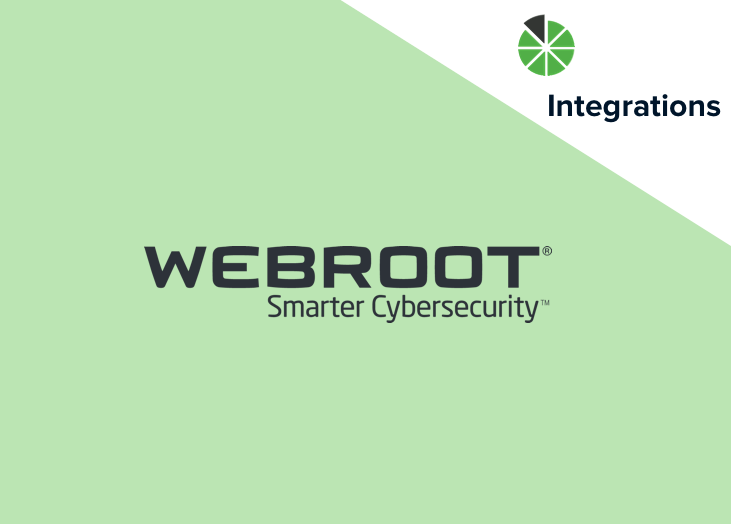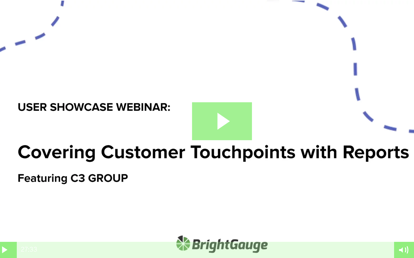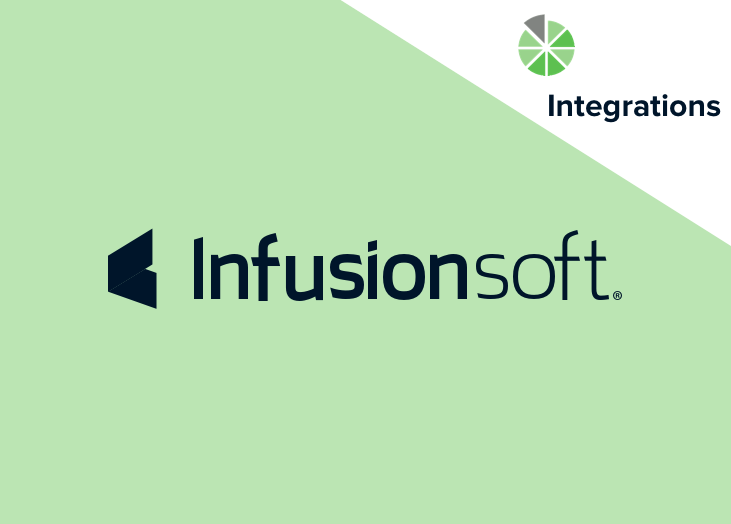We’ve got a new datasource for you! In case you missed it, we recently added Infusionsoft to our list of integrations that you can connect with. Infusionsoft is a tool that helps you with your ...
We’ve got a new datasource for you! In case you missed it, we recently added Infusionsoft to our list of integrations that you can connect with. Infusionsoft is a tool that helps you with your marketing needs. When you pair it with BrightGauge, you’ll streamline your marketing efforts so that you can create more opportunities with your customers. With Infusionsoft, you can organize all of your customer interactions, automate your CRM marketing activities, score and prioritize your lead list, send customers personalized emails, and more. BrightGauge takes it one step further by giving you a birds-eye view of your campaigns at any given time, in one simple place. If you’re ready to kick your marketing up a notch, it’s easy to get started. How to Connect to Infusionsoft If you’ve already got a BrightGauge account, then you know it’s pretty simple to connect to new and existing datasources. Just visit your BrightGauge homepage, head to the datasources panel to find Infusionsoft, and enter your credentials. If you need more help, no worries. Our support team has put together a step-by-step guide for connecting. What Do I Get Out of the Box? With every new integration we bring into our family, we make every effort to make it easy for you to view your data as soon as you connect. We talk to customers like you, find out which key performance indicators (KPIs) matter most, and pre-build gauges, dashboards, and reports to reflect those findings. With Infusionsoft, you’ll get 51 gauges, five dashboards, and two report templates right out of the box. Need a more complicated and detailed build-out? Our support team can help you with that. Gauges When it comes to marketing and CRM, what are customers like you looking at? Our 51 default gauges help you visualize important data like Contacts Created This Week, Emails Sent This Week, Published Campaigns, Opportunities Won This Week, Emails Opened Rate, and more. Dashboards Five default Infusionsoft dashboards compile your important KPIs into one, easy-to-view screen. Rotate between Contacts, Email Open Rates, Opportunities This Week, Opportunities Today, and Tasks so that you never miss a good opportunity. If needed, you can drilldown to get more details. Reports Business owners and managers know that it takes a lot of work to build long-term client relationships and that those relationships are based on trust and transparency. Reports are a powerful tool to build on that trust because it doesn’t get more transparent than showing the facts and figures that are a result of your work. BrightGauge makes it easy to to set up a report once and then schedule it to go out on a recurring date and time of your choice, to the clients you want. Try it with the two report templates we’ve built out for you (Weekly Summary and Monthly Summary), and then give it a whirl on your own! Goals If you’ve integrated with Infusionsoft, this is a great opportunity to take advantage of our Goals feature, which can motivate your team and encourage a culture of accountability. Each person on your sales and marketing team can create goals based on overall KPIs and then track them each week (for example, have enough leads been generated this week?). Get ready to be more productive! There’s a lot you can do with BrightGauge + Infusionsoft, so if you’re ready to upgrade your plan to include this datasource (or others), please reach out to our Success team. As always, let us know what you think!

At BrightGauge, we are proponents of fostering a team spirit. We don’t work in silos, we make sure everyone has visibility to all company projects, and we’re constantly hanging out together, both in and out of work. However, we’re also strongly encouraged to work independently. It may seem counterintuitive, but it is wholly possible to be both team-driven and an independent worker, and we’ve found that this approach results in highly creative thinking. We are Managers of One Have you been introduced to the concept of a manager of one? In the simplest of terms, it’s basically somebody who doesn’t need to be told what to do. Think of a typical manager at any workplace: they are expected to set the tone for their team, come up with goals, execute and analyze them, and work productively without a lot of direction from the executive level. A manager of one is expected to work the same way, but for themselves. This is great for so many reasons. Being a leader for yourself First, when you’re hired as a manager of one, you understand that a lot of trust has been placed in your abilities and capacity to get things done. This is an awesome vote of confidence that feels like years of hard work paying off. However, one must not forget that this comes with a big responsibility - you’ve got to live up to expectations. At BrightGauge, we simply see it as motivation! Secondly, you can kiss micromanaging goodbye. Nobody likes to work with someone standing over their shoulder, watching their every move, making sure it’s done to their liking. No thank you! As a manager of one, no one is breathing down your neck. You know what you’ve got on your plate and you’re given the autonomy to get it done in the time and manner you see fit (within reason, obviously). One of my favorite aspects of being a manager of one is that possibilities seem endless. Take 30 seconds to think about five things you look for in a new job. Was ‘room for growth’ on your list? It’s always on mine. As a manager of one, you can carve out your own path and show your worth in so many ways. And since you don’t have somebody dictating your every move, you really have the freedom to get creative and control what your role looks like and what it will evolve into. Which brings us to our next point. Our creativity bells are ringing loudly When you are given the space to be independent, introspective, and self-reliant, your mind can go to wondrous places. Working alone frees up space in the mind and allows for the creation of new thoughts, ideas, and processes. Many innovators and leaders throughout history have spoken of the importance of being alone. Pablo Picasso said, “Without great solitude no serious work is possible.” Inspirational inventor Nikolas Tesla said: “The mind is sharper and keener in seclusion and uninterrupted solitude. Originality thrives in seclusion free of outside influences beating upon us to cripple the creative mind. Be alone—that is the secret of invention: be alone, that is when ideas are born.” The impact of creativity on BrightGauge Software BrightGauge is a technology company. You might think, “what does technology have to do with creativity?”. Well, a lot, in fact. Creativity isn’t reserved solely for artists, writers, poets, and filmmakers. If you think about BrightGauge on a deeper level, we’re more than just technology creators. We’re in the business of helping people live better and easier lives. Putting it in that context, it’s clear that creative thinking is needed to build a great product, with intuitive features, a smart design, a robust support team to back it up, proactive marketers to get the word out, and so on. Some of our best ideas - which have resulted in improved product features like moveable gauge layers - have come out of independent, focused deep work sessions: periods of time where we’re each able to work without interruptions, on our own, with the goal of achieving high-quality work. Without pressure from the top and by eliminating unnecessary distractions, we’re able to get to the deeper level of thinking we all strive for. Where do teamwork and independence intersect? While a lot of our work, thinking, and ideating is done alone, no level of output would be possible without the entire team coming together. You may already know that we use Basecamp on a daily basis to manage our projects and keep our weeks organized. When somebody lands on an idea they’d like to explore further, the first step is to pitch it to the entire company (or to specific team members, if desired) on Basecamp. That way, everyone can voice their approvals, concerns, ideas to make the concept even stronger, etc. No project moves forward without buy-in from the team. We’ve found what works for us and it’s inspiring to thrive within such a creative environment. We’ll never stop coming up with ways to improve - and it’s highly possible a golden idea will strike when one of us is in our own little focused bubble. You may like our management style, but it’s always good to hear from others. Check out our free webinar, ‘In Service to The Team’, to listen in as Todd Kane of Evolved Management Consulting talks about his approach to management.

If you know us at all, you know we love talking about how much inspiration we draw from companies and people we admire. There’s so much to learn from industry leaders who have “been there, done that” so to speak, and there’s no shame in recognizing that we’ll always have room to grow. At BrightGauge, we’re huge fans of Jason Fried and DHH and what they’ve done with their super successful company, Basecamp. They seem to have found a sweet spot when it comes to balancing work and life. Basecamp employees are hard-working and productive, but still find time to explore the hobbies and passions that make them happy. We love that. So not only do we actually use their product on a daily basis, but we’ve also tried to adopt some of the work habits that make their culture so unique. One such habit - a big one for us - is trying to eliminate unnecessary distractions. We’re Focused on Staying Focused How many times have you left a meeting and thought everything could have been accomplished with a simple email? Or worse, the meeting time ran out so you set up another meeting to keep the conversation going (what I like to call ‘a meeting about a meeting’). This is an incredibly frustrating aspect of working at many companies. So, when the good folks at Basecamp started writing about the idea of eliminating recurring meetings and status meetings, it struck a chord with us. It was something we had already been thinking about, so reading about how others were doing it inspired us. You know, that whole ‘be the change’ thing. And we did it! We said goodbye to meetings. No more weekly status meetings. No more formally putting time on someone’s calendar in order to get questions answered. No more spending half your workday stuck in meetings and away from your actual work. If a meeting is absolutely necessary, we’re encouraged to limit it to 15 minutes when possible, or even to meet over lunch. There are, obviously, exceptions and special circumstances but we try our best to practice what we preach. Once we started working this way, a funny thing happened. Less Meetings, Way More Productivity When we got our work hours back, everything started to change. Suddenly, if one of our developers was deep into writing a complicated piece of code, he wouldn’t be forced to interrupt his train of thought just to attend a meeting that likely didn’t carry any urgency with it. Instead, he could continue to be laser-focused on his project without pressure to be anywhere else, meaning he’d probably have an uber-productive day. Productivity lends itself to higher-quality work. It’s not just a coincidence. Less Meetings, Less Anxiety I started to realize something recently. This corporate culture of having lots of meetings on our calendars is causing us to operate in an anxious state. In previous jobs, I remember opening my calendar at the start of the day, seeing the hours upon hours that were blocked for meetings, and thinking “when the heck am I going to tackle my to-do list?”. Sometimes, I even had meetings that overlapped with other meetings. We’re somehow expected to be in multiple places at once while consistently producing good and on-time work. Some days, I’d get home from work and be totally drained and exhausted. Not to mention, I’d be at work late, since my to-do list wasn’t checking itself off just because I was in a meeting. Having a wide-open calendar with plenty of freedom to actually complete to-do list items does wonders for the mind and soul. It allows you to go about your day with a sense of calmness, instead of feeling the buzz of high-anxiety coursing through your veins. You can actually take a deep breath and focus. You can actually smile at your co-workers instead of rushing past them yelling, “I’m late for my 3:00!”. You can actually get to work. What a concept. Quality Matters, A Lot When did we get into this habit of trying to do everything? Why do we treat it like its an accomplishment when someone says they worked 90 hours in a week and barely got any sleep? Why are we sacrificing our health and our free time just to say we did more, more, more? You know what people are actually going to notice? When a job is well-done. When you can tell that time and care were put into it. And when the product or service you’re working so hard on actually truly helps the end user. Cal Newport, author of Deep Work (a BrightGauge favorite), said, “If you don’t produce, you won’t thrive - no matter how skilled or talented you are.” It’s true. We need to be afforded the space and time to create. We’re living in the age of information where quality is king. There’s no shortage of information out there (i.e. quantity) but not all of it is worth our time (i.e. quality). Meetings, social media, a 24-hour news cycle, pool tables - they’re all distractions, and distractions hurt our focus much more than we think. Phasing out meetings is about more than just taking away a tedious task we all roll our eyes at. It’s about retraining our brains to remain focused and to be better. So, How Do We Communicate Internally? It’s a good question. Let us be clear. Doing away with meetings is no excuse for working in silos. We still very much stress the importance of good communication and visibility. Now, instead of talking about something out loud in a meeting, where people are most likely not even taking notes, we just write it all down. We use Basecamp to keep things orderly and organized. Something that could have been said in a weekly status meeting is instead written in a Basecamp post and shared with relevant co-workers. Anyone who has a question can pose it in the same thread and all pertaining notes and comments will live in that thread forever. It’s awesome, really. It’s so easy to go back and reference, plus it saves a ton of time that would have been wasted asking people to rehash what was said in a meeting or digging through lots of different emails to try to piece the puzzle together. The mental clarity you get from knowing you have 8 solid hours a day (give or take) to get your work done is insanely valuable. Add in the fact that Basecamp has your back and it’s no wonder that the quality of work will noticeably go way up. Make Small Changes at First It can be pretty jarring to jump to a meeting-free culture, so we took Fried’s advice on this one. He recommends getting rid of one meeting a month, then one a week, and so on. This has made a huge difference in our rate of productivity and the quality of work we’re putting out - whether that’s in blog posts, new product features, support team responses, or even our sales calls. Try it out and see how it works for you. We’d love to hear about it. Want even more productivity tips? Check out our free webinar, ‘Managing Productivity of a Service Team’, to learn how one of our customers leads his Service Team operations.

Announcing the latest integration to launch at BrightGauge: Webroot! Webroot is a powerful cybersecurity software that pairs really well with BrightGauge by allowing you to stay on top of devices that need your attention. Some of Webroot’s main features include antivirus and anti-spyware protection, firewall capabilities, online backup, password management licensed from LastPass, protection against identity theft and credit card monitoring for US customers. Many of our customers are already Webroot users and a lot of you have been requesting this integration for a long time. We’re happy to finally add this datasource to our roster so that you can begin monitoring and managing security operations for your business. How to Connect to Webroot Connecting with Webroot is easy. Once you’re in your BrightGauge account, visit the datasources panel to find Webroot and simply enter your credentials. Our support page includes a step-by-step guide for getting started. What Can I Get Right Out of the Box? The whole point of BrightGauge is to make it easy for you to view all the data you care about in one place, so we also want to make it easy to get started as soon as you open an account. That’s why we deliver out-of-the-box gauges, dashboards, and reports for all of our integrations, which you’ll find when you’ve connected to Webroot. Of course, you always have the freedom to customize your dashboards and reports to display the exact information you want, and our support team is always available to lend an extra hand. We’ll be adding more Webroot defaults over time, but for now get started with two pre-built dashboards and 15 gauges with corresponding reports. Gauges When it comes to cybersecurity, you really want to prevent disasters by being proactive and catching any glaring issues immediately. Default gauges like Attention Required, Infection Status, Realtime Shield Status, Sites, Scans and more help you stay ahead of the game. Dashboards There are two default dashboards that come with your Webroot integration: Infection Status and Sites. Infection Status will give you a look at the sites that require your immediate attention and how many active threats you’ve received this week or month. Sites will display details for each particular site. Remember that you can always drilldown further to get more detailed information. Reports Currently, we have two report templates ready to go, which are generated from our default gauges. One is a Weekly status report and the other is Monthly. We recommend that you kick things off with these templates, but then go ahead and customize them so that they display exactly what you or your client want. With BrightGauge, you can set up a report once and then set it to automatically go out on a recurring basis. Once you’ve got a handle on your data and your KPIs, you and your team can set action-driven Goals that can be tracked each week. This is a really awesome way to establish a culture of accountability and motivation and to run a more productive organization! We love hearing from you, so please make sure to leave us some feedback if you’re looking for more out of your Webroot integration. If you’re ready to upgrade your plan to include more datasources, reach out to our Success team.

Compuquip Cybersecurity is a Miami based, family-owned business that focuses on cybersecurity products and services for their enterprise partners. Since 1980, they’ve helped businesses address their network infrastructure and cybersecurity needs. The Compuquip team makes it a point to equip businesses of all sizes with the tools they need to manage any risks. In today’s information age, it’s an absolute necessity to safeguard your networks against outside intrusion. A need for efficiency Although Compuquip remains focused on their core mission, they do face the day-to-day realities of running a well-organized business. Like all technology partners (and any business for that matter), they find it important to track what their engineers are doing and to report on critical work that’s being handled. In the past, they found difficulty in processing their orders. Compuquip services many customers on a daily basis, covering a very sensitive topic. There’s a sense of urgency that naturally permeates the cybersecurity industry, as issues can unfold very quickly, so it’s important for technology partners to have a timely view of the status of orders and networks. Additionally, Compuquip had no real-time reporting. Everything was done via a manual report, which meant they had to take data from their system, literally type it into an Excel spreadsheet, massage the spreadsheet, convert it to a PDF, and then send it out internally or to clients. This was done for every single report on a daily, weekly, monthly, quarterly, and annual basis. As a company that is continually optimizing their cybersecurity offerings and adding more clients to their roster, it makes sense that Compuquip looks for ways to maximize their efficiency. Adopting BrightGauge Adriel Argote, Accounting Manager at Compuquip, had a request form his CEO: Compuquip needed visibility into the operations in each department of the company. To assist with that, Adriel helped implement BrightGauge as a trusted business solution. “We brought in BrightGauge in several different areas. We brought it in to automate our daily reporting of all the deals we close. We brought it in for our weekly aging report. We brought it in for sales reporting, so we can see how our sales team is doing month-to-date, quarter-to-date, and year-to-date. And we’ve also used it for tracking of our engineers - who’s billing, who’s not billing, how much time are they billing?” Through their integrations with Microsoft Dynamics GP and Harvest, Compuquip has everything they need to keep track of order processing, engineering, invoicing, time-tracking, billing, and more. sample Harvest dashboard How BrightGauge Has Saved Compuquip Time Since bringing on BrightGauge’s dashboards and reporting features, the Compuquip executive team has seen a significant shift in how departments are spending their time. As Adriel explained, “BrightGauge’s automated reporting has saved about 15 minutes every day for the daily report. We calculated it out to be between 8 to 10 hours a week that we are now saving in man hours, while getting much more accurate information. That’s a lot of time!” Although there’s an incredible amount of value in time saved, the Compuquip team has noticed an added benefit to using the features that BrightGauge offers. “It brings in a level of transparency for the team. When we find something that looks off on a dashboard or report, we jump in in real-time instead of waiting for the report to come out at the end of the day or week. We’re catching things faster, so errors are going down.” Favorite Feature Through BrightGauge’s reporting feature, Compuquip has been able to buy back time spent on mundane, but necessary tasks and, in turn, can focus on hitting KPIs in areas that truly matter - making sure each and every customer is satisfied with the level of security and attention they are receiving. “Allowing us to focus on what we need to do, instead of creating reports, reduces errors and saves us a lot of time, which makes us more efficient. And then having all the information in real-time where I can see it is a huge, huge victory for us.”

70+ Metrics for MSPs
Key metrics and accompanying formulas to help MSPs skyrocket growth and success!
Get your KPIs

In case you missed it live, here’s your opportunity to watch our most recent webinar, featuring Ryan Giles, founder of Traction Strong. In the webinar, Ryan and BrightGauge CEO Brian Dosal talk all about how to improve the efficiency of your business by implementing the Entrepreneurial Operating System (EOS) process made famous by Gino Wickman’s book Traction. Simply put, EOS is a framework for building a business with an actionable and trackable plan for success. Many MSPs and other companies in the technology sector have adopted the EOS process because it is easy to implement and has proven to be effective. In the webinar, Ryan and Brian cover: What a successful business plan looks like Common issues that many companies face The 6 key components of EOS What it takes to implement EOS into your business How to create and track goals quarter by quarter Ryan himself saw a 30% year-over-year growth immediately after implementing the EOS process in his MSP. After this webinar, you’ll be armed with valuable information that can put you on your own path to growth! “Vision without traction is just hallucination!” - Ryan Giles Watch ‘Guiding Growth Through EOS & Goals’ now to learn more about the simple process you can take to optimize your business.

A lot of users really like working with BrightGauge because of our capability to integrate with many popular business solutions on the market. The whole point of our app is to make it easy for you to see important metrics from your PSA, RMM, and financial tools all in one place. You might be asking how we go about choosing the tools that we integrate with. Great question! Two-fold approach When we’re looking into business solutions to add to our roster of integrations, there are basically two things we take into consideration: what you - our customers - are asking for and what that solution’s documentation looks like. Listening to our customers BrightGauge began on the idea that we could help make the lives of business owners and managers a bit easier. From experience, we knew how much time was spent creating reports each week or logging in and out of multiple accounts and we figured there was a smarter way to use our time. Our attempt to improve lives, however, would be meaningless if we didn’t take the time to listen to our users wants and needs. Many of you submit requests to integrate with your favorite business tool, and we really take those requests into serious consideration. If we’re receiving multiple requests for one specific tool, that makes a pretty compelling argument to bring it into our system. That’s not to say that we only focus on popular requests. There have been instances where just a handful of our end users would benefit from a specific integration, but that benefit would be so tremendous that it became a no-brainer to add it in. What we’re trying to say is don’t be shy about telling us what you need! In addition to listening to you, we rely on our own experience and knowledge, too. Once upon a time, we were the customer, so we’re aware of what the MSP owner’s daily life looks like. We know which tools are being used most often and which key performance indicators (KPIs) to track because we’re really engrained in the industry. Dissecting the tool Once we’ve made the decision to take a specific solution into consideration, it’s time to inspect that tool. Generally, we’re asking ourselves two questions: What kind of support exists for those looking to integrate? Which KPIs will the tool allow us to track? If the tool we’re looking to integrate is hosted, or cloud-based, it’s essential to look into their API. What does it look like? How is it written? Will it be simple for us to connect to that API? Will the integration be seamless? How much work is there to do on our end? Is there a sandbox account we can use for testing while we set up the integration? What kind of authorization does the API use (we prefer OAuth 2.0)? If on premise, what does the SQL database structure look like? Are the fields well defined? Does the database support querying by third parties? Once we’ve deemed the tool’s documentation as friendly, we’ve got to check out their KPIs. What are they allowing us to track and measure? How much data will you, our customers, be able to extract from this tool? If you aren’t able to see KPIs that matter to you and your organization, then what’s the point? We don’t want to create noise - we want to take actions that will make a difference. Looking ahead As we continue to improve upon our product and welcome more customers into the BrightGauge family, surely we’ll add new integrations to the mix. We’re looking forward to announcing new integrations in the coming weeks. In case you missed it, we recently added Infusionsoft to our list! We know lots of customers like you are using these tools on a daily basis, so these are big. Stay tuned for more on this. How to voice your needs Our Support team is an incredible resource when it comes to helping our customers, whether you’re having issues with your dashboards, needing help building out a more complex gauge, or trying to connect a new datasource to your account. We highly recommend that you visit our support page. Here, you can email our data team with your own integration requests, open a support ticket for bugs you may be experiencing, or browse the knowledge base for a little self-help and troubleshooting.

Think about the night before you start a new job. You might feel nervous, anxious, excited, or apprehensive, riddled with questions like, Will they like me? Is this the right fit? Am I going to eat lunch all by my lonesome? Then, before you know it, you feel 100% comfortable at work. You even look forward to Mondays (imagine that!), knowing you can catch up with friends and dive into a new work week. Heck, you’ve even managed to get your coworkers to follow your random Slack channel! You try to conjure up feelings of the night before your first day and suddenly, it’s a completely foreign feeling. When and how did this happen? This, my friends, is the magic of effective onboarding. And I’m feeling it just two months into working at BrightGauge. Getting in the BrightGauge groove It’s been 66 days since I started at BrightGauge. I’ve learned a whole lot in just this short period of time. I love it here and feel quite lucky to have found this opportunity. A lot of BrightGauge users talk about how awesome it is to work with us on a personal level and I now understand why. What I’ve learned in two months This team kicks booty. We may be small, but we are mighty. Everybody here shares a strong work ethic and a passion for making sure our customers are taken care of. It’s easy to stay motivated. No one is wasting hours. We’re all respectful of one another’s time and spaces, and we all make an effort to stay focused and to put into practice the mindfulness learned from reading Cal Newport’s Deep Work. But, we love to have a good time. Have you ever just hung out at work past closing hours on a Friday? Because you want to? I wouldn’t have believed it 67 days ago, but when you get a great group of people together, it’s natural to gravitate towards friendships. A good bottle of wine never hurts. We don’t do meetings. Let me rephrase that. We try to avoid meetings as much as possible. These tend to take up a lot of unnecessary time and distract us from focused, deep work. Fewer meetings means more productive days. If we are to meet, we try to do it over lunch or in a focused 15-minute catch-up session. We’re not big on emails, either. This was wild to me at first. I couldn’t believe we weren’t expected to be tethered to emails 24/7. Instead, we believe in business organization and thorough documentation through tools like Basecamp and it’s a game-changer. Aside from having visibility into different teams’ projects (buh-bye, silos), using Basecamp boosts our team spirit, too. For example, every Monday, we all post weekend photos and anecdotes. It’s so nice to share these parts of our lives with one another. Everyone is willing to help. I do not have a tech background, so I love to ask lots of questions to really grasp the ins and outs of our software. My colleagues are my greatest resource for this. They are all patient, super intelligent, and more than happy to chat for as long as it takes to get my questions answered. I love that camaraderie. Constant learning is highly encouraged. BrightGauge places an importance on furthering one’s knowledge and passions by inviting us to attend industry conferences or even by switching internal departments. We are motivated to feel fulfilled and work optimally within our roles. We’re always on the lookout to ensure that the right person is in the right seat. We’re ever-evolving. Expanding our minds is just one piece of the puzzle. When it comes to making improvements on the services we offer, it’s all hands on deck. Every employee at BrightGauge is encouraged to pitch feature requests, discover and fix bugs, provide honest feedback, and look for new solutions. After all, we do actually use our own product. Good, valuable work can happen outside of the office chair. Yes, it can happen from home, from a coffee shop, from a co-working space, or from a chateau in France. BrightGauge encourages everyone to work remotely, especially since it’s been found to get your creative juices flowing and inspire new thoughts and ideas. I find it amazing that being committed to my work doesn’t mean relegating laundry to weekends only or having to miss out on seeing the world. Why our culture works for us Leadership. Brian and Eric Dosal founded BrightGauge on the idea that they could help make people’s lives a little better. That remains our focus and number one priority. Their vision has always been clear and they exude that in a way that’s contagious. Core values. People want to work here because we offer a really good service, with good intentions, surrounded by good people. It’s honest, straightforward, and humble work. Our team leads take a lot of time to fill available roles because the only way this will continue to work is if every single employee is committed to good-ness, in terms of relevant experience and fitting into our unique culture. Onboarding. A Basecamp feature we love is the ability to create to-do lists per person, team, or project. I’ve found that one really effective BrightGauge onboarding practice is that each new hire starts his/her first day with an already-set 90-day to-do list in his/her Basecamp folder. Talk about an awesome way to immediately make someone feel like he/she has purpose within a team. It’s a really simplistic example. Consistent onboarding processes go a long way in setting workflow and culture precedents. My (unsolicited) advice for you Stay true to you. Every business owner has a unique working style and a unique set of beliefs and values. There’s no need to compromise on that or to disregard it and settle for a conventional way of working. Operate the business you want to operate so you’re always honoring your truth. Have a process. Even if you have the most casual of laid-back work environments, have a process. Establish some rules. Be organized. Don’t be lackadaisical in your business approach because guess what? Your employees will be lazy in their approach, too. Track quarterly progress. Consider implementing Goals into that process. It helps employees to be accountable and driven towards success. Encourage work/life balance. Your employees live outside of their job. If they feel like their personal time is highly valued, they’re more likely to value their work time by being more productive and dedicated. Be good. This world is, frankly, saturated with mad and crazy people, events, situations. Why add to it? Operate with the best of intentions for all. I leave you with this oft-referenced Ferris Bueller quote: Life moves pretty fast. If you don’t stop and look around once in a while, you could miss it. This is true with work, too. Stop, digest what you’ve learned, appreciate where you are, and work really hard at being your best. Time - even at a brand new job - just flies by. Great employees are one way to improve your business, but setting the right KPIs can also make a huge difference. Download our free whitepaper, How To Improve Your Business With KPIs, for our tips.

A strong work team is marked by a mix of employees who are dedicated, proactive, solutions-oriented, supportive, and always willing to help each other out. Above all else, successful team members have got to be productive and accountable. Good managers encourage productivity and accountability by being motivating leaders and by knowing when to step in to lend an extra hand. Managers can’t do it alone, though. In a work environment that encourages independent thinking and ‘managers of one’, what can be done to increase the rate of productivity? For one thing, you can put everything in plain view, with dashboards. What you accomplish with dashboards Aside from streamlining your business and keeping sensitive data organized, BrightGauge dashboards just keep things real. They are comprised of gauges that analyze data and key performance indicators (KPIs) of your choosing, in real-time. The data you view syncs automatically, so everything you see is current. This means you can’t hide from hard facts. Visible data takes employee performance and hangs it out to dry, where everyone can take a peek. See how many support tickets Jane has resolved today. Look into stats behind a customer account to see why they might’ve churned. It’s all there with the right integrations. Accountability becomes a given When the truth is out in the open and accessible, the only option is to be accountable. You have no choice but to own up to everything you do, both good and bad. And that’s awesome. It’s true what they say - when you have no lies to hide behind, it kind of sets you free. It allows you to say, “This is who I am and this is what I’ve done” and it motivates you to always perform to the best of your abilities because, honestly, we’re humans and we like looking good in front of our peers. With accountability comes the acceptance and awareness of where improvements are needed. It becomes easier to push for productivity Visual cues are really powerful. If your boss is trying to raise $10,000 for an important cause, and verbally tells you she’s raised $5,600 so far, that’s cool. If she shows you a gauge that gets filled in with green with each dollar raised, that’s even better! It becomes almost like a game to completely fill in the gauge and there’s an actual emotional response that comes along with fulfilling your goal. It’s the same with work (or even personal) goals. If Jane’s goal is to respond to tickets within 30 minutes of receiving them, and her average response time is displayed on dashboards on flat-screen TVs around her office, you better believe that she’s going to do everything she can to get that average time down to 29 minutes or less. She’s going to be incredibly motivated to help her company meet important goals and to set new personal records. This is a win-win for all. It’s important to motivate, not discourage BrightGauge dashboards serve two main purposes: they put your KPIs on display in one easy-to-access place, and they motivate teams. Remember that: motivation is key. Using KPIs to track employee and company goals is smart. But turning that data against team members is dangerous. Nobody should be discouraged or shamed for their performance and goals do not have to be strictly set in stone, forever (glaring or repeated issues are an exception, of course). Instead, dashboards should be used as a barometer for health and as a conversation starter. We believe that regular check-ins and reviews help a company remain profitable and efficient, and the data gathered from dashboards can help kick off those check-ins. If applied correctly, dashboards and goals act as a guiding light for employees, rather than as a point of pressure. Dashboard Best Practices Some quick tips to optimally using dashboards for productivity and accountability: Be upfront with KPIs so that every employee has insight into company goals Encourage employees to come up with their own goals; this emphasizes the importance of being accountable Use our rotating dashboards feature to get a complete view of all your important data and to drive productivity Schedule regular, honest check-ins with your team to make sure nothing is falling through the cracks Learn the right way to set and track goals, establish a cadence, and drive your organization forward using accountability.

What do you think of when you hear the word ‘job’? Probably a situation where you perform a specific task and earn a paycheck for it, right? There’s a different definition for ‘job’ and it can radically transform your business approach, making you more laser-focused and maybe more successful. It has to do with what life benefit your customer is looking to gain from using your service. More on this ahead. What about ‘marketing strategy’? What does that involve? Do you typically create a strategy based on target demographics? A buyer’s persona? As direct competition to a similar service that’s already being packaged by someone else? Do you focus on the service attributes itself? If you’re nodding your head, you’re not alone. Traditionally, we’ve been taught to look at marketing from this perspective. A lot of companies get their start by looking at an existing product or service and deciding “oh, we can do that better”. But what if we’ve been taught wrong? Another perspective exists and there’s a strong argument out there for changing your strategy. A different approach to marketing We’re talking about wholly shifting your focus to the customer’s emotions. What is the user’s situation? How can your service help them make progress in their lives? What job does the customer actually need your product or service to do for them? The argument is the theory of Jobs to Be Done (‘job’ meaning the progress a person is looking to make). It is not a new theory. It’s been documented in many books like a favorite of ours, Competing Against Luck, by Clayton M. Christensen. It has been applied by successful companies like Uber, Unilever, and Deseret News. Yet, many people are still confused by or unaware of it. To help put this theory into perspective, check out the commonly cited ‘milkshake theory’: At BrightGauge, we like this simplistic approach. While a little difficult to put into practice, we’ve found it helpful to look into how other companies are answering to the jobs their customers are hiring their services to do for them. Start by talking If you’re in the process of identifying the needs of your own customers, you may be asking where should I start? The answer is so obvious that it almost feels wrong. The best place to start is to talk to current customers. Ask brand new users what prompted them to make the switch from another service to yours. Don’t neglect recently churned customers - ask what caused them to leave. More likely than not, you’ll discover some incredibly helpful insights. You may even find your product or service is being used in different ways than you intended, which is not a bad thing! Quick example: Uber may have been started to help passengers have a great experience while getting from point A to point B, but the founders probably didn’t think some would use it as an alternative to owning a car. When talking to your users, it’s pretty important to get down to small, seemingly insignificant details. If you ask John why he hired an Airbnb rental over a hotel room and he answers, “it was a good price”, you can’t stop there. The fair cost is not the reason John is making progress in his life. What emotional value does Airbnb bring to John? With a little probing, you’d be able to discover that his true underlying need was to feel like he was actually living in the city he was visiting. He wanted to feel at home and Airbnb could do that job better than any hotel room. Before talking to customers, it might help to understand the typical timeline in a buyer’s decision process: Consider the ‘consideration set’ While you’re talking to customers, think about the emotional value your product or service brings. Keep the ‘consideration set’ in mind as you formulate new ideas for improving your service. That is, the other products that compete with your product. In John’s example, you might be tempted to think that all other Airbnbs or hotels in the market are the only existing competitors. Not true. Remember what he hired Airbnb to do (feel at home in a foreign city). Instead of an Airbnb, John could have hired a friend’s couch, leased an apartment, or done nothing at all. Conversely, he could fire his current home and move to the new city (kinda drastic, but not impossible). Don’t fall into the trap of believing you’ve got a service with zero competitors. You have to ask yourself if it’s really such a good thing to be on your own in the market. Is that an indication that your product is not a right fit? A little healthy competition is a good sign of future growth opportunities. It can be easy to think of products and services that are similar to your own, but it takes more effort to identify the less obvious competitors. However, this effort can lead to big rewards. The 5-Hour Energy Story Manoj Bhargava was perusing the energy drinks available at a tradeshow he was attending, in hopes of finding a pick-me-up. He realized the products on the shelf were too big - he wasn’t thirsty enough to consume a large energy drink. Also, he also didn’t want the extra sugar and junk commonly found in those drinks. He dreamt of a healthier and much smaller energy booster. When thinking about where in the supermarket to place it, he didn’t think it made sense to place it next to sodas, or water bottles, or other large drinks because customers needed a boost, not a thirst quencher. Instead, Manoj thought of the check-out area. Customers needed something convenient, quick, and that would help them have a productive day. Out of those needs, 5-Hour Energy was created. Chock full of vitamins and less than 3 ounces, it’s an effective grab-and-go solution. So effective Manoj is now a billionaire. Had Manoj thought to place 5-Hour Energy alongside Gatorade (an obvious competitor), the story may have turned out differently. Putting on a BrightGauge lens We are constantly exploring new ways to help our customers improve their lives through the use of BrightGauge. Through trial and error, plus a lot of talking to customers, we’ve come to understand that we’re here to help them easily see all their KPIs, impress their clients, and motivate their team. This all makes a really big difference to a lot of people’s businesses. Our work isn’t done though. Figuring out your product/service and the emotional value it delivers to people is just one piece of the puzzle. How do we apply this same frame of thought to other areas of business, like marketing? Base your communication on emotions, not features Every marketing strategy involves a lead generation campaign of some sort. If you’re not generating leads, you’re not gaining customers. No customers means no business. In today’s age of digital marketing, there are many tactics to choose from, ranging from pay-per-click (PPC) to retargeting campaigns to personalized emails. The method you choose is not as important as the message you put out there. So many times, you see ads that try to lure leads in by screaming “FREE Trial!” or “Lose 10 Pounds in 1 Day” (a.k.a., a totally unrealistic promise). Your customers are smarter than that. They will recognize click bait when they see it. With all the screens in their lives flooded with messages like that, how do you expect to stand out? Instead of focusing on shiny-gimmicky features, talk to customers about how your service will help them. Bring their emotions into the picture, because that’s what they will connect with. We like what Snickers has done. They’re not marketing themselves as “the best chocolate ever”. That’s just an unsubstantiated and very subjective claim. Their slogan is, “Hungry? Why Wait?”. First of all, everyone can relate to being hungry hangry. It makes you tired, cranky, moody, whatever. So, instantly a connection has been made. Secondly, they’re alluding that a Snickers can replace a meal. They’re helping their customers by keeping them full enough to get on with their activities and to last until dinnertime. Suddenly, Snickers is competing with a sandwich, and they become the best-selling candybar on the market. Genius. How we provide value through facetime We mentioned three key ways that BrightGauge helps customers make improvements on a daily basis. Working off of those insights, we realized that not every new customer is seeking the same solution. So, how do we communicate in a way that’s resourceful and truly valuable? We ask questions and we do it in person. BrightGauge is simple to use, but our users’ needs can get complicated. We like to take a hands-on approach to helping them find solutions. Through Data Driven Workshops or Customer Site visits, we ask our customers what they are looking for. Based on their answers, we tailor our demonstrations to provide the most value to each individual. For example, if a customer mentions that they are looking for a way to show their worth to their clients, we know we can help them gain more business through our reporting tool, which is a powerful way to build trust and credibility with clients. It’s more efficient for them because they’re getting comprehensive and valuable answers and they’re able to dive deep into our product. It’s helpful for us because face-to-face time goes a long way in building lasting relationships with quality customers. Plus, it’s fun for us! Take a new approach to your business plan If you’re trying to think of the next “big idea” or if you’re finding ways to strike gold, dial it back a bit. Take time to ask yourself “how can I make people’s lives better?” instead of “how can I create a super cool service?”. See where you can inject an extra bit of positivity into someone’s day, and hopefully, make them feel like a superhero for their team. It’s not really about reinventing the wheel here. It’s truly about making a positive difference in people’s daily lives. Consider the pain points that would drive someone to hire your service and fire the one they had already been using. Put yourself in the customer’s shoes and imagine the life events that cause you to take action in your own job. Remember: Job doesn’t always mean employment. It can mean progress being made in one’s life Consider a customer’s emotional, functional, and social situation - context and circumstance matter Your existing competitors may be in an entirely different product category Always use a lens of “how can I help my customer?” and not “look, what I offer is so pretty!” There’s a whole lot to learn about the Jobs to Be Done (JTBD) theory and, if anything, it’s an interesting lens with which to view marketing. We’ve found this site and this site to be helpful resources in learning more about this theory, but our ears are always open! How have you applied JTBD to your world?

We’re constantly working to make sure you’re getting the most out of your BrightGauge, and adding new integrations to our roster is one way we can do that. This week, we’re announcing Freshdesk as the latest integration you can connect with. Freshdesk lets you get a handle on your service desk by tracking incoming tickets, time entry, service level agreements (SLAs), and more. When you integrate Freshdesk with BrightGauge, you can easily stay on top of your work by having a real-time view of your service desk at any given time. That means there’s less of a chance that anything will ever fall through the cracks. How to connect to Freshdesk Like all integrations, we make it simple to connect to any of our available datasources. If you’ve already got an account, just visit your BrightGauge homepage, head to the datasources panel to find Freshdesk, and enter your credentials. If you need more help, no worries. Our support team has put together a step-by-step guide for connecting. If you’re new to BrightGauge, you can request a demo right now. What do I get out of the box? Our main goal when it comes to BrightGauge is to make your life a little easier. That means it needs to be super simple for you to get started right away. We’ve done the legwork to discover which key performance indicators (KPIs) matter most to you and have pre-built gauges, dashboards, and reports based on that. With Freshdesk, you’ll get 74 gauges, five dashboards, and three report templates right out of the box. Need a more complicated and detailed build-out? Our support team can help you with that. Gauges Managing your service desk is all about staying on top of incoming tickets and keeping your response time low. Our 74 default gauges track first response, resolution, survey response, billable hours, new, open, and pending tickets, tickets closed, unopened tickets, and more. Dashboards Five default Freshdesk dashboards compile your important KPIs into one, easy-to-view screen. Rotate between SLA, Service Desk, Service Desk Leaderboard, Service Manager, and Tech Dashboard. If needed, you can drilldown to get more details. Reports Reports are a great way to build transparency and trust with your clients or even your internal teams. BrightGauge makes it easy to to set up a report once and then schedule it to go out on a recurring date and time of your choice, to the clients or teams you want. Try it with the three report templates we’ve built out for you (Executive Summary, Technician Daily Review, and Week in Review), and then give it a whirl on your own! Goals Are you looking for a way to build accountability within your teams while keeping them motivated? So many users love our Goals feature for this very reason. Each person can set up a personal goal based on overall KPIs (for example, ticket response time below 5 minutes) and then track them each week. Everyone has visibility to goals, so there’s no reason not to hold yourself accountable. BrightGauge + Freshdesk can help make you more productive and efficient, so if you’re ready to include this datasource in your plan, please reach out to our Success team. We’d love to hear your thoughts!












